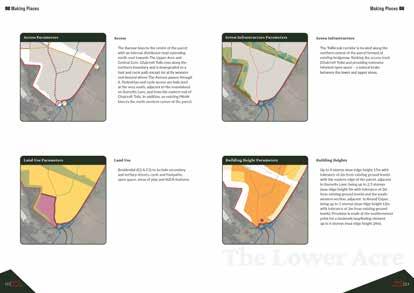
3 minute read
3.0 Using the Design Code
03 Using the Design Code

3.1 Background to the Design Code
3.1.1 The Design Code has one key function to articulate - translating how the technical detail secured by the outline planning application could be delivered in an acceptable form. Done successfully, this will bridge the gap between the outline planning application and future applications to ensure and capture the benefits of a composite approach.
3.1.2 Whilst the process of creating the Design Code was informed by many stakeholders, including the local community, its intended audience is principally practitioners involved in formulating and determining future applications. This will include Town Planners, Architects, Urban Designers, Landscape Consultants, Transport Consultants, Ecologists, Drainage Consultants, Utilities Consultants, Sustainability Consultants and many others.

at One Horton Heath
3.2 Working with the Design Code
3.2.1 Appreciating this diverse but principally technical audience is key to the way in which the Design Code is set out as, if the content is not displayed in a usable format, then its aspirations will not be harnessed by future practitioners and employed correctly to the benefit of the development.
3.2.2 The Design Code therefore seeks to align itself with the planning process recognising the elements of the development that are fixed, and cannot be changed by future applications, and where there is space for creativity and direction. To do this, whilst considering a diverse range of topics, the Design Code will clearly identify:
• Where it relates to Fixed elements that future applications must incorporate;
• Where it relates to Fixed elements that must be incorporated but are subject to a tolerance meaning that a future application has some discretion with regard to how that
Fixed Flexible element is delivered; and, • Where it is advocating a design concept or aspiration which demonstrates how a particular challenge may be met but, ultimately, there is discretion for future applications to decide how best to achieve that Flexible Innovation aspiration.
3.2.3 By adopting this approach the requirements and expectations of both the applicant and Local Planning Authority are set, and there can be no room for misinterpretation.
3.3 How to Use the Design Code
3.3.1 The Design Code seeks to secure the highest quality of development at One Horton Heath.
3.3.2 As discussed opposite, this is best achieved by through hierarchy of Fixed, Fixed Flexible, and Flexible Free elements which combine to respond to the parameters of the Outline Planning Aplication to deliver on the aspirations of the Project Overview.
3.3.3 The following pages therefore set out how a ‘typical’ part of Section 8: Making Places could look to demonstrate how the information should be interpreted.
• Fixed Parameters
• The prescriptive Fixed requirements must be complied with in future applications.
• They are fundamentally described by the Parameter
Plans, which accompany this
Design Code as part of the
Outline Planning Application.
• Flexible Parameters
• The indicative Flexible requirements establish ways in which both the applicant and Local Planning Authority consider future applications could deliver an acceptable development.
• They do not have to be strictly adhered to, but by virtue of their evidenced design procecss, should be robustly justified in any departure.





